A bit longer than 250 million years is when we had the Great Dying, the Permian–Triassic extinction event, when up to 96% of all marine species and 70% of terrestrial vertebrate species became extinct. A mere 65 million years ago saw the extinction of the dinosaurs and the dawn of the Cainozoic Era. From a screenshot of this YouTube, this is how the continents were placed around the globe:
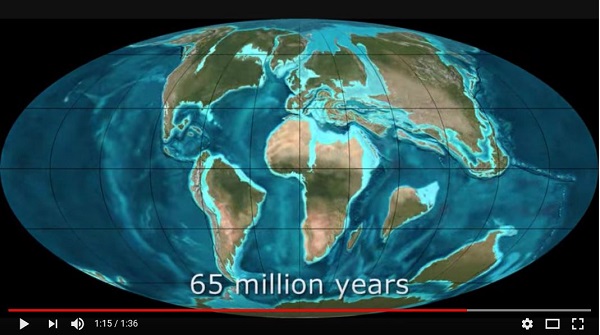
India was on its way to slam into Asia, Eurasia had not yet formed and South America had split off from Africa.
This YouTube shows the shape of things in 100 million years time:
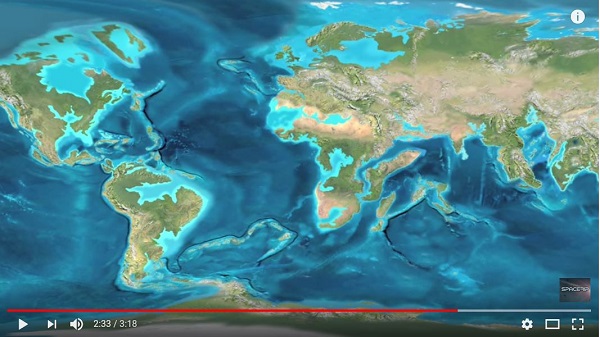
A bit of a mess, really.
Of course, the temperature and the shape of the ocean basins will determine how much land is showing.
A recent New Scientist article by Stephen Battersby (pay-walled) plotted possible futures out to 250 and 300 million years. Here’s one for 300 million:
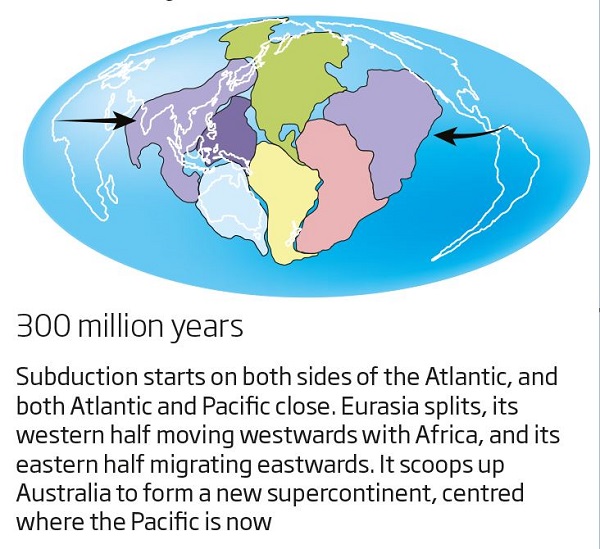
And another for 250 million:
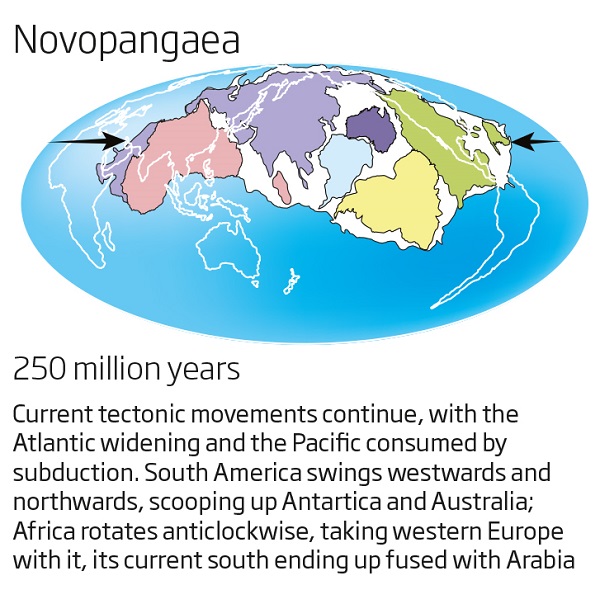
The money seems to be on a new supercontinent, probably to the north, with or without Antarctica. If you had an ice sheet on both poles it would make a difference to sea levels and climate.
The truth, however, is that beyond about 50 million years it is basically guesswork.
There are three main functions going on. Firstly, plates can slam into each other as with India and Asia. Secondly, you can have mid-ocean upwellings. Thirdly you have subduction zones, where one plate slides underneath the other.
You can see the active areas in this map of earthquakes from 1963 to 1998:
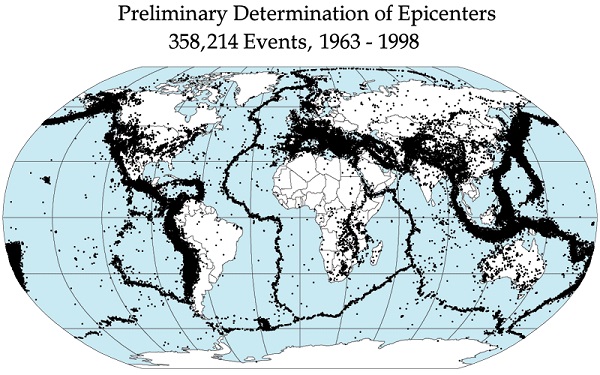
The major uncertainty is that scientists have no idea at all how new subduction zones form. They come from deep inside the earth’s surface, and are may millions of years in the making.
I’ve been intrigued by the Andes Mountains, where the 65 million years map shows the intrusion of the ocean along the west coast. Research a few years ago indicates that the Andes only started to rise 30 million years ago and was near full height 14 million years ago. Until then the Andes were thought to be younger, about 14 to 10 million years ago.
An intriguing factoid is that Ecuador’s Mt Chimborazo at 6,263m is actually the furthest point from the earth’s surface to its core.
James Hansen in his Iowa Testimony in 2007 explains how continental shifts and the upwelling of mountains affect the climate over long periods. Here is a rough picture of continental drift:
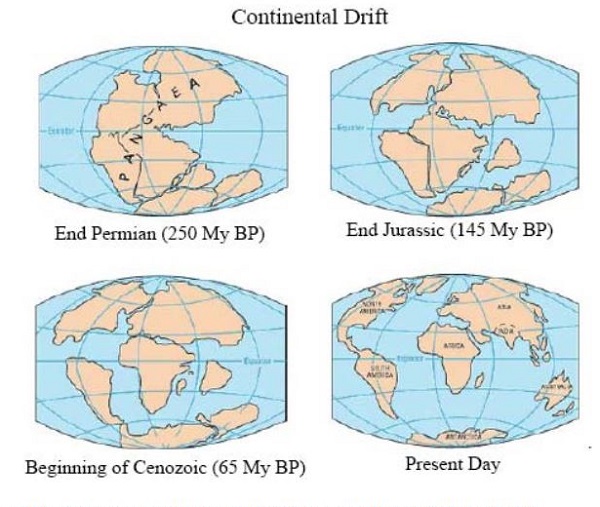
Here is how the temperature changed in the last 65 million years:
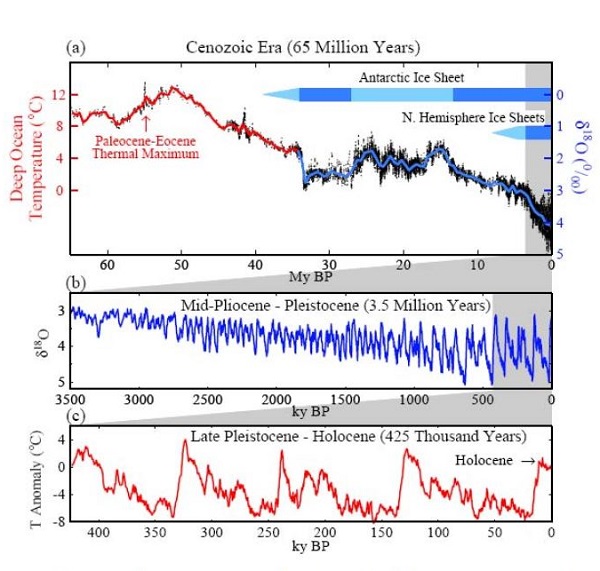
It changes very slowly with evolutionary processes able to respond. Something very different is happening now, with the sixth great extinction well under way.
250 million years would be an extraordinarily long time for a species like Homo Sapiens to survive. The realistic prospect is that nature will survive the plague-like infestation of this topline predator and destroyer of habitats like no other, and return to a gentler process where species continue to evolve and prosper. It may be a question of what damage we do on the way out.
Or will we learn to align with the underlying processes of change?
Nature’s big brain experiment is on the line.

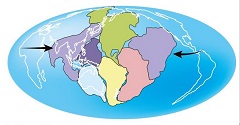
I’ll need to check the 59-page Iowa testimony, but from memory weathering rock takes CO2 out of the atmosphere, and the rise of the Andes probably saved us from complete deglaciation again and put the planet on a path where in recent times the Holocene has provided Goldilocks conditions for the spread of Homo Sapiens across the globe.
Personally, I’ll be fully and untraceably dispersed, fairly widely, as mostly bonded atoms.
Dunno about the rest of youse.
Cheerio
CO2 can dissolve in rainwater forming the weak acid called “carbonic”.
H2CO3 from memory.
Apologies for my pre-dispersal loquacity.
The molecular assemblage Ambi.
Saw a book review in New Scientist where the book claimed that human transport systems had effectively recreated Pangenia, the mega continent at a time when all the continents had come together. (Human transport has made it possible for a whole range of species to move between continents, things like humans, dingoes and cane toads.)
The writer saw this defacto Pangenia providing a stimulus to evolution.
The weathering of calcium containing rocks by dissolved CO2 creates soluble bicarbonates that are converted to relatively insoluble carbonates that are incorporated into shells, coral reefs etc,.
Some proposals for future cement production convert calcium and magnesium containing rocks into cements that actually remove CO2 from the air during cement curing. (Conventional cement is made by heating a mix of limestone and materials such as clay to a high enough temperature to drive out the CO2 in the limestone and create calcium minerals. The cement sets by the conversion of these minerals to hydrates and carbonates. The amount of CO2 absorbed is less that expelled during manufacture. The cement industry is responsible for about 5% of world CO2 emissions.
BZE is in the process of issuing an emission reduction plan for cement Key points:
Cement certainly needs to be sorted, and it seems that it can be.
On the paleoclimate issue, Hansen’s Iowa testimony tells us in ancient times carbon was buried through sedimentation to form fossil fuels, plus:
Chemical weathering is the more dominant. Then:
Burial and outgassing are not in balance, which produced climate change., but very slowly over long time periods. The rate of geologic changes to atmospheric CO2 is only about 0.0001 ppm CO2 per year, compared to more tha 2ppm per year now. From geological forcing you get about 100 ppm change in a million years.
Every year we put carbon from fossil fuels into the atmosphere that took 100,000 to get there via sedimentation.
When geologists tell us there always has been climate change and always will be, they need to do the calculations which Hanson has done.
Humans are disrupting geology in a huge way. They call for empirical evidence. There you have it!
Of course since the Panama Isthmus closed over 3 million years ago, the Milankovitch cycles have taken over as the main driver, before humans came along.